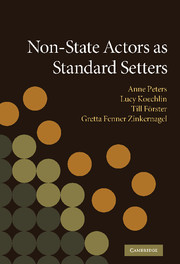Book contents
- Frontmatter
- Contents
- List of figures
- List of tables
- List of contributors
- Acknowledgements
- List of abbreviations
- Preface
- 1 Non-state actors as standard setters: framing the issue in an interdisciplinary fashion
- PART I New actors and processes in contemporary standard setting
- PART II The legitimacy and accountability of actors and standards
- 8 Democratic governance beyond the state: the legitimacy of non-state actors as standard setters
- 9 Legitimacy, accountability and polycentric regulation: dilemmas, trilemmas and organisational response
- 10 Accountability of transnational actors: is there scope for cross-sector principles?
- 11 Non-state environmental standards as a substitute for state regulation?
- 12 Limiting violence – culture and the constitution of public norms: with a case study from a stateless area
- PART III The authority and effectiveness of actors and standards
- Index
- References
11 - Non-state environmental standards as a substitute for state regulation?
from PART II - The legitimacy and accountability of actors and standards
Published online by Cambridge University Press: 06 January 2010
- Frontmatter
- Contents
- List of figures
- List of tables
- List of contributors
- Acknowledgements
- List of abbreviations
- Preface
- 1 Non-state actors as standard setters: framing the issue in an interdisciplinary fashion
- PART I New actors and processes in contemporary standard setting
- PART II The legitimacy and accountability of actors and standards
- 8 Democratic governance beyond the state: the legitimacy of non-state actors as standard setters
- 9 Legitimacy, accountability and polycentric regulation: dilemmas, trilemmas and organisational response
- 10 Accountability of transnational actors: is there scope for cross-sector principles?
- 11 Non-state environmental standards as a substitute for state regulation?
- 12 Limiting violence – culture and the constitution of public norms: with a case study from a stateless area
- PART III The authority and effectiveness of actors and standards
- Index
- References
Summary
Background and context
Environmental impacts of large infrastructure, industry, and resource extraction projects have been a concern for a considerable time. The development of environmental legislation in the advanced industrialised countries of the North reflects this concern. Such legislation includes laws that have been created to address air and water pollution stemming from industrial production (for example, the US Clean Water Act and Clean Air Act), other statutes that regulate zoning and construction of new developments (for example, the EU Water Framework Directive), and a set of procedural rules that require the consideration of potential environmental impacts before new developments are undertaken (for example, the US National Environmental Policy Act). Such public environmental standards tend to be less detailed in transition and developing countries. Coalitions of actors concerned about the environmental performance of infrastructure, industry, and resource extraction projects in such countries have consequently sought other means of improving the environmental performance of projects. In the absence of state actors willing or capable of creating and enforcing strict environmental rules in their respective countries, these coalitions have targeted private sector and international actors that play crucial roles in the constructing and financing of projects in developing and transition countries.
Financial institutions have been most prominent among the actors targeted by concerned activist coalitions. This chapter explores the effects of environmental rules for project finance and considers the possible impact that rules among other parties involved with project development could have.
- Type
- Chapter
- Information
- Non-State Actors as Standard Setters , pp. 304 - 323Publisher: Cambridge University PressPrint publication year: 2009
References
- 2
- Cited by

